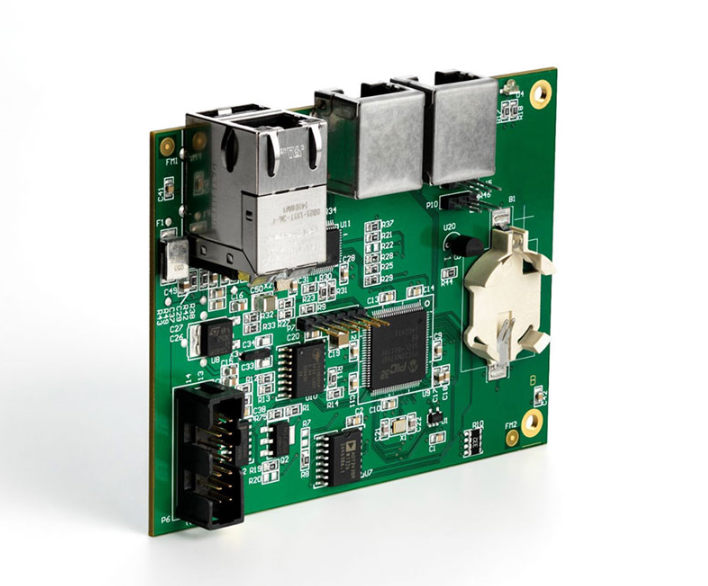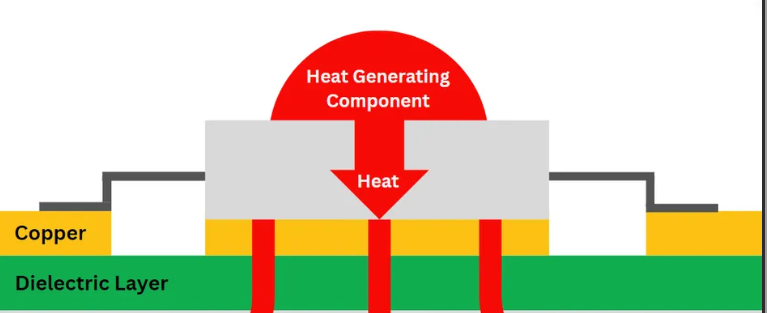In the fast-evolving world of unmanned aerial vehicles (UAVs), reliability is everything. Whether it’s a drone used for aerial photography, agricultural monitoring, or military applications, the printed circuit board (PCB) at the heart of the system must withstand harsh conditions. This is where High-Tg PCB materials come into play. High-Tg (high glass transition temperature) materials are specially designed to handle extreme temperatures and thermal stress, ensuring the reliability of PCBs in UAVs. In this blog, we’ll explore how High-Tg PCB materials enhance drone performance, focusing on thermal management, material selection for high-temperature environments, and overall reliability.
At ALLPCB, we understand the unique challenges of designing and manufacturing PCBs for drones. Let’s dive into the critical role of High-Tg materials in ensuring UAV PCB reliability under demanding conditions.
What Are High-Tg PCB Materials and Why Do They Matter for Drones?
High-Tg PCB materials are substrates with a higher glass transition temperature (Tg), which is the point at which a material shifts from a rigid to a more flexible state. Standard PCB materials often have a Tg of around 130°C to 140°C, while High-Tg materials typically range from 170°C to 180°C or higher. This increased thermal threshold makes them ideal for applications where heat resistance is crucial, such as in UAVs.
Drones often operate in extreme environments, from scorching deserts to freezing altitudes. The internal components of a drone, including motors, batteries, and processors, can generate significant heat during operation. Without proper thermal management, this heat can cause PCB delamination, warping, or component failure. High-Tg materials help mitigate these risks by maintaining structural integrity under high temperatures, making them a top choice for UAV PCB design.

Understanding UAV PCB Thermal Stress and Its Challenges
Thermal stress in UAV PCBs occurs when temperature fluctuations cause expansion and contraction of materials at different rates. This mismatch can lead to cracks, solder joint failures, or even complete board failure. For drones, thermal stress is a significant concern due to their compact designs and exposure to varying environmental conditions.
For example, a drone flying at high altitudes may experience ambient temperatures as low as -20°C, while internal components generate heat up to 100°C or more during intense operations. This temperature swing of over 120°C can strain standard PCB materials beyond their limits. High-Tg PCB materials for drones are engineered to handle such extremes, reducing the risk of mechanical failure and ensuring consistent performance.
Additionally, UAVs often use high-power components like GPUs and RF modules, which can produce localized heat spots on the PCB. Without adequate thermal management, these hot zones can degrade nearby materials or components. High-Tg materials provide a robust foundation to withstand these conditions, enhancing the overall reliability of the system.
PCB Material Selection for High-Temperature UAV Environments
Selecting the right PCB material for high-temperature UAV environments is a critical step in design. While cost and availability are factors, thermal performance and reliability take precedence in drone applications. Here are key considerations for choosing High-Tg materials:
- Thermal Stability: High-Tg materials maintain their mechanical properties at elevated temperatures, preventing warping or delamination. For instance, a material with a Tg of 180°C can reliably operate in environments where temperatures reach 150°C without losing structural integrity.
- Low Coefficient of Thermal Expansion (CTE): Materials with a low CTE reduce the risk of cracking during temperature changes. High-Tg substrates often have a CTE of around 10-13 ppm/°C, compared to 14-17 ppm/°C for standard FR-4 materials, making them more suitable for UAVs.
- Dielectric Properties: Drones rely on high-frequency signals for communication and control. High-Tg materials often offer stable dielectric constants (Dk) of around 3.5 to 4.5 and low dissipation factors (Df) of 0.01 or less, ensuring minimal signal loss even under heat stress.
Common High-Tg materials include advanced FR-4 variants, polyimide, and PTFE-based laminates. Each offers unique benefits depending on the specific requirements of the UAV application, such as weight constraints or signal integrity needs.

Reliability of High-Tg PCBs in UAVs: A Game Changer
The reliability of High-Tg PCBs in UAVs is a defining factor in their growing adoption across industries. Drones are often deployed in mission-critical scenarios where failure is not an option. High-Tg materials contribute to reliability in several ways:
- Enhanced Durability: High-Tg PCBs resist cracking and delamination during thermal cycling. Tests show that boards with a Tg of 170°C can endure over 1,000 thermal cycles (from -40°C to 125°C) without significant degradation, compared to just 500 cycles for standard materials.
- Improved Solder Joint Integrity: High temperatures can weaken solder joints, leading to failures. High-Tg materials maintain stability during soldering processes, even with lead-free solders that require temperatures above 260°C.
- Long-Term Performance: UAVs used in industrial or military settings may operate for extended periods. High-Tg PCBs ensure consistent performance over time, reducing maintenance costs and downtime.
For instance, in agricultural drones that monitor vast fields under direct sunlight, High-Tg PCBs can prevent failures caused by prolonged exposure to heat, ensuring uninterrupted data collection. Similarly, in defense applications, where drones face extreme conditions, the reliability of High-Tg PCBs can be the difference between mission success and failure.
Thermal Management in UAV PCBs: Strategies and Solutions
Effective thermal management in UAV PCBs goes beyond material selection. While High-Tg materials provide a strong foundation, additional design strategies are essential to dissipate heat and maintain optimal performance. Here are some proven approaches:
- Heat Sinks and Thermal Vias: Adding heat sinks to high-power components and incorporating thermal vias (small holes filled with conductive material) can transfer heat away from critical areas. Thermal vias with a diameter of 0.3mm and a copper thickness of 1 oz can reduce local temperatures by up to 20°C.
- Layer Stack-Up Design: Optimizing the PCB layer stack-up by placing high-heat components on outer layers or near thermal dissipation paths can improve heat flow. A 6-layer PCB with dedicated ground planes can enhance thermal distribution.
- Material Thickness: Using thicker High-Tg laminates (e.g., 2.0mm instead of 1.6mm) can improve heat capacity, though it must be balanced with weight constraints in UAV designs.
Combining these strategies with High-Tg materials creates a robust thermal management system tailored to the unique demands of drone operations. For example, a delivery drone operating in hot climates can benefit from a combination of High-Tg substrates and strategically placed thermal vias to prevent overheating during long flights.

Benefits of High-Tg Materials Beyond Thermal Performance
While thermal resistance is the primary advantage of High-Tg PCB materials for drones, their benefits extend to other areas of UAV design:
- Mechanical Strength: High-Tg materials are less prone to bending or breaking under physical stress, which is vital for drones that endure vibrations during flight.
- Chemical Resistance: Exposure to humidity, dust, or chemicals in outdoor environments can degrade standard PCBs. High-Tg materials offer better resistance, prolonging the lifespan of UAV electronics.
- Compatibility with Advanced Processes: High-Tg PCBs support advanced manufacturing techniques like HDI (High-Density Interconnect) designs, allowing for smaller, lighter boards without sacrificing reliability—a key factor for compact drone designs.
These added advantages make High-Tg materials a versatile choice for UAV manufacturers looking to optimize performance across multiple dimensions.
Challenges and Considerations When Using High-Tg Materials
Despite their benefits, High-Tg PCB materials come with certain challenges that designers must address:
- Higher Costs: High-Tg materials are typically 20-30% more expensive than standard FR-4 substrates. However, the cost is often justified by the increased reliability and reduced risk of failure in critical UAV applications.
- Processing Requirements: Manufacturing High-Tg PCBs requires precise control over lamination and drilling processes due to their higher rigidity. This may increase production time or complexity.
- Weight Considerations: Some High-Tg materials are denser than standard options, which can impact the overall weight of the drone. Designers must balance thermal performance with flight efficiency.
By working with experienced PCB manufacturing partners, UAV designers can navigate these challenges and optimize their designs for both performance and cost-effectiveness.
How ALLPCB Supports UAV PCB Reliability with High-Tg Materials
At ALLPCB, we specialize in providing high-quality PCB solutions tailored to the unique needs of UAV applications. Our extensive range of High-Tg materials ensures that your drone PCBs can withstand thermal stress and deliver reliable performance in any environment. We offer:
- Custom material selection to match your specific thermal and mechanical requirements.
- Advanced manufacturing capabilities for precise fabrication of High-Tg PCBs.
- Expert design support to optimize thermal management strategies in your UAV PCB layouts.
Our commitment to quality and innovation makes us a trusted partner for drone manufacturers seeking to enhance reliability through cutting-edge PCB solutions.
Conclusion: Elevating UAV Performance with High-Tg Materials
The role of High-Tg materials in unmanned aerial vehicle PCB reliability cannot be overstated. From managing UAV PCB thermal stress to ensuring long-term performance in high-temperature environments, these advanced substrates are essential for modern drone designs. By prioritizing PCB material selection for high-temperature UAV environments and implementing effective thermal management strategies, manufacturers can build drones that are not only reliable but also capable of tackling the toughest challenges.
Whether you’re designing a drone for commercial, industrial, or defense purposes, High-Tg PCB materials offer the durability and performance needed to succeed. At ALLPCB, we’re here to help you navigate the complexities of UAV PCB design and bring your vision to life with top-tier manufacturing solutions.



